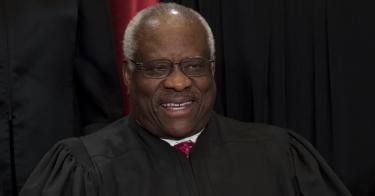When an irresistible force meets an immovable object, so the old song goes, “something’s gotta give.” So, when the force is an originalist view of judicial authority and the object is the doctrine of stare decisis, which one gives? Justice Clarence Thomas says it has to be stare decisis.
By way of background, originalism holds that the Constitution should be interpreted according to what its words were commonly understood to mean at the time of ratification. Originalist judges, like Justice Thomas, believe their role is limited to faithfully interpreting the original meaning of the Constitution.
Stare decisis (Latin for “let the decision stand”) is the judicial policy that says courts are bound by their prior decisions. Even when a prior decision has misinterpreted the Constitution, the court may still adhere to it on the grounds that doing so promotes stability in the law and preserves the legitimacy of the judicial process.
Justice Thomas thinks the latter idea is wrong, and he aired the issue last week in his opinion in Gamble v. United States (2019).
Terance Gamble was prosecuted twice — once under Alabama law and once under federal — for the same conduct: being a felon in possession of a firearm. This, Gamble argued, violated the Fifth Amendment prohibition of double jeopardy.
The court disagreed. It reasoned that the double jeopardy clause protects individuals from being tried for the same “offense,” which means law. The law is determined by the “sovereign,” of which there are two: Alabama and the federal government. Thus, when there are two sovereigns, there are two offenses. So even if the laws are identical and the underlying criminal conduct is the same, there’s no double jeopardy problem if someone is tried separately under both state and federal law.
Justice Thomas concurred in the judgment but wrote separately to address the “proper understanding of stare decisis in our constitutional structure.” In short, he argued that a judge’s duty to interpret the Constitution correctly trumps stare decisis, and if the courts got it wrong in the past, then they need to fix it rather than stick with incorrect precedent.
Stare decisis “might have made sense in a common-law legal system in which courts systematically developed the law through judicial decisions apart from written law,” Justice Thomas wrote. But, he argues, ours is “a system of written law” in which “the systematic development of the law is accomplished democratically.” Thus a judge’s proper role is to “interpret and apply written law to the facts of particular cases.”
If, he says, the court confronts an old decision that misinterprets the Constitution or statutory law, then the court should overrule it regardless of any concerns for legal stability or judicial integrity. After all, an incorrect decision “is tantamount to making law,” and sticking with that decision undermines the Constitution and, with respect to statutory interpretation, allows unelected judges to usurp Congress’ power.
Justice Thomas allows for one exception to overruling old decisions: Courts can still follow a decision that is a “textually permissible interpretation of the law.”
No other member of the court joined Justice Thomas‘ concurring opinion in Gamble, but his view is, in fact, the correct one.
The Constitution is “the supreme Law of the Land,” and a judge’s job is to interpret it properly. When judges interpret the Constitution incorrectly, they go from “call[ing] balls and strikes,” as Chief Justice John G. Roberts Jr. once put it, to making law. And when unelected judges make law, they undermine the democratic process.
Ultimately, the best thing for legal stability, judicial integrity and a healthy republic is a Supreme Court dedicated to getting the Constitution right. If that means scraping away layers of old judicial varnish, then all the better.
This piece originally appeared in The Washington Times




